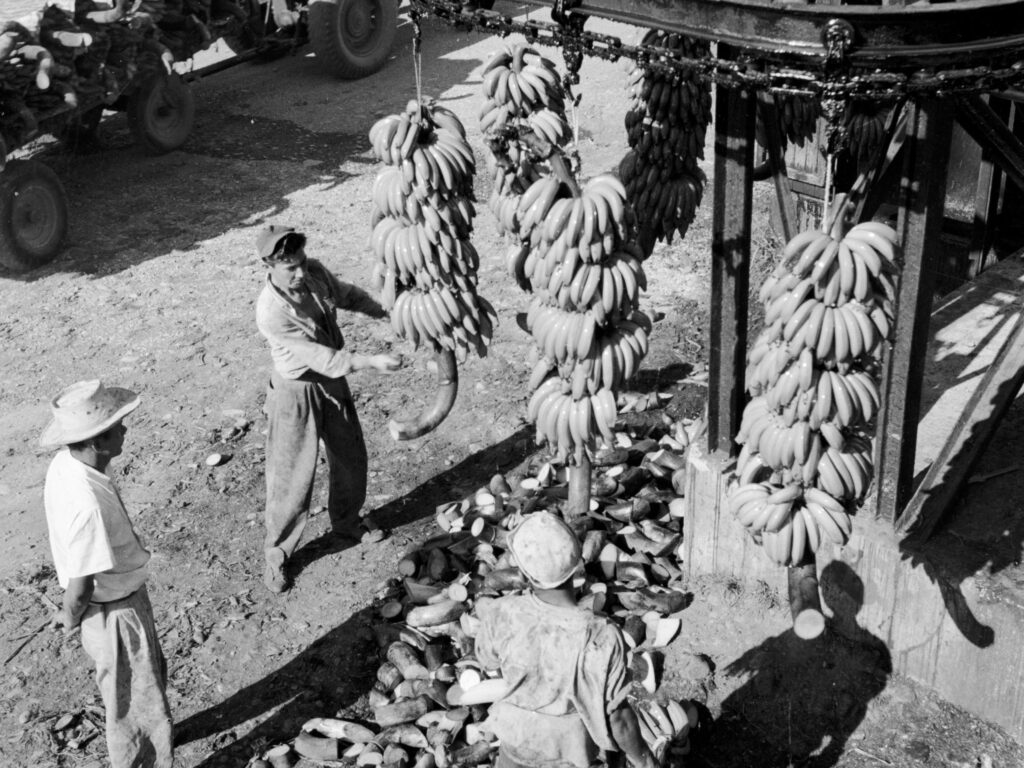Bananas, with over 100 billion individual fruits produced annually, stand as one of the world’s most beloved and crucial crops. Over a thousand varieties cater to different tastes and needs globally, but beyond their popularity as a food item, bananas are integral to the livelihoods of millions worldwide.

Origins and Early Domestication
The origin of the banana begins in the lush landscapes stretching from India to Southern China and Northern Australia.
Wild bananas, first domesticated around 5,000 BC in Papua New Guinea, were initially unappealing, laden with hard seeds and less flesh.
Through natural hybridization, more palatable varieties emerged, leading to the cultivation of seedless bananas, propelling their spread across the globe.
The Austronesian Expansion
The Austronesians, a group of people originating from Taiwan around 3,000 BC, played a pivotal role in disseminating bananas.
As they ventured across Maritime Southeast Asia and beyond, they established extensive trade networks and introduced bananas to new regions.
By 1100 BC, bananas had reached the Middle East, and by 200 AD, they were being cultivated in China. Their agricultural importance continued to grow, significantly influencing cultures and economies wherever they traveled.
Cultural Impact and Historical Significance
Bananas are mentioned in ancient texts, such as a Nepali Canon Buddhist script dating back to 600 BC, highlighting their significance in early societies.
In India, the banana became a symbol of fertility and prosperity, often associated with Lakshmi, the goddess of wealth.
Interestingly, the plant also influenced the development of several writing systems in Asia, with the curved letters of scripts like Sinhala and Burmese potentially shaped by the physical characteristics of banana leaves, which were used as writing surfaces.
European Encounter and Spread to the Americas
Bananas were known to the ancient Greeks and Romans but became more widely known in Europe during the Crusades.
However, it wasn’t until the Portuguese and Spanish explorers encountered them in West Africa that bananas began their true global spread.
Introduced to the Caribbean and the Americas in the early 16th century, bananas quickly became a staple crop, reshaping the agricultural landscape of the New World.
The Emergence of Banana Giants
Advances in transportation and refrigeration significantly boosted the banana industry’s growth.
The invention of steamships and the improvement of refrigerated cargo hold in the late 19th century allowed highly perishable bananas to be transported over long distances from tropical growing areas to markets in Europe and North America.
This technological leap turned bananas from an exotic curiosity into an everyday food item in temperate zones, drastically increasing the demand.
The rising demand for bananas catalyzed the formation of powerful fruit companies, most notably the United Fruit Company, founded in 1899 by merging several smaller entities.
This company, along with its competitors like the Standard Fruit Company and, later, the Kuel Fruit Company, began to exert significant influence over the production and distribution of bananas.
They invested heavily in banana plantations, built railroad networks, and established port facilities, creating the infrastructure needed for large-scale banana exportation.
The economic impact of the banana industry on Central American countries was monumental. Bananas became one of the top exports of these nations, generating crucial foreign exchange needed for their developing economies.
However, this dependence on a single export commodity made these countries vulnerable to market fluctuations and the political whims of the corporations controlling the banana trade.
Political Influence and “Banana Republics”
The term “banana republic” was coined to describe the political instability and neocolonial dependence that arose in countries heavily involved in banana production.
United Fruit and other companies acquired vast tracts of land and exerted disproportionate influence over the governments of these nations.
They were often involved in or responsible for instigating coups and other political maneuvers to install regimes favorable to their business interests.
In some notorious cases, these companies colluded with the U.S. government to protect their interests.
For example, United Fruit played a role in the CIA-led coup to overthrow the democratically elected president of Guatemala in 1954, a move justified by Cold War dynamics but largely motivated by the company’s fears of losing land and power due to the president’s agrarian reform policies.
Challenges and the Future
Despite their success, bananas face significant challenges. The Gros Michel variety, once dominant, was nearly wiped out by Panama disease in the mid-20th century, leading to the rise of the Cavendish variety, which now accounts for the majority of global banana production.
However, the Cavendish is now threatened by a new strain of Panama disease, TR4, posing a severe risk to the global supply.
This ongoing threat highlights the need for genetic diversity and the development of disease-resistant banana varieties.

